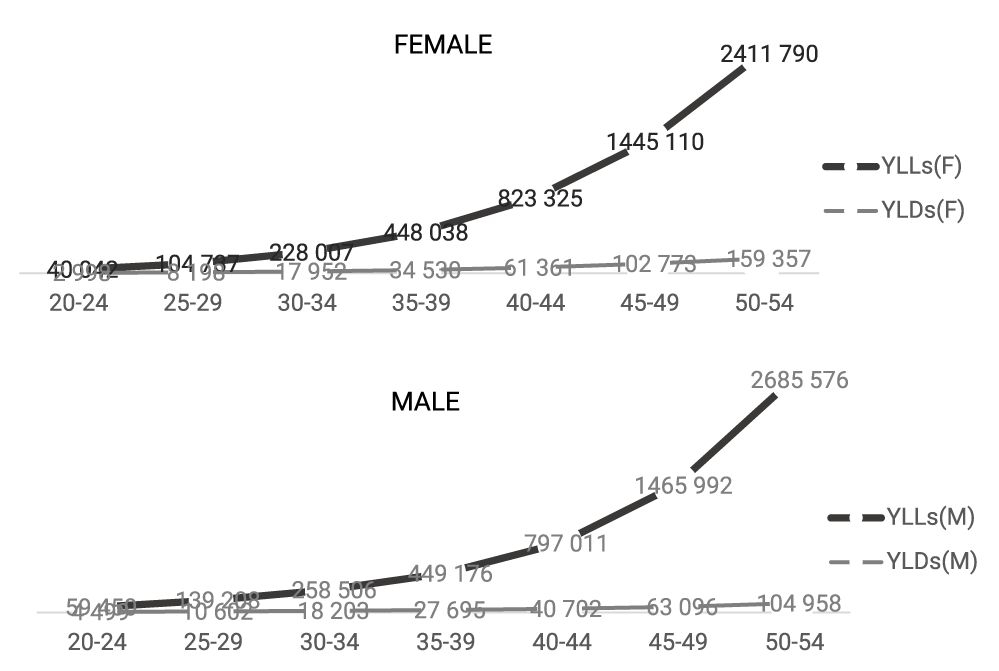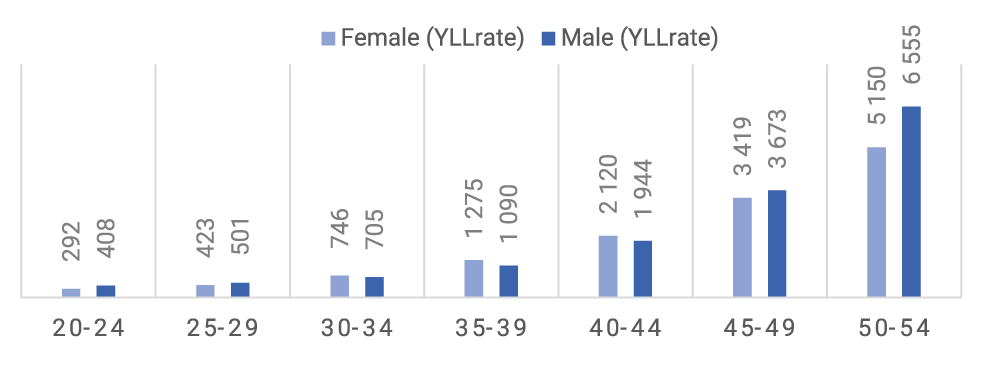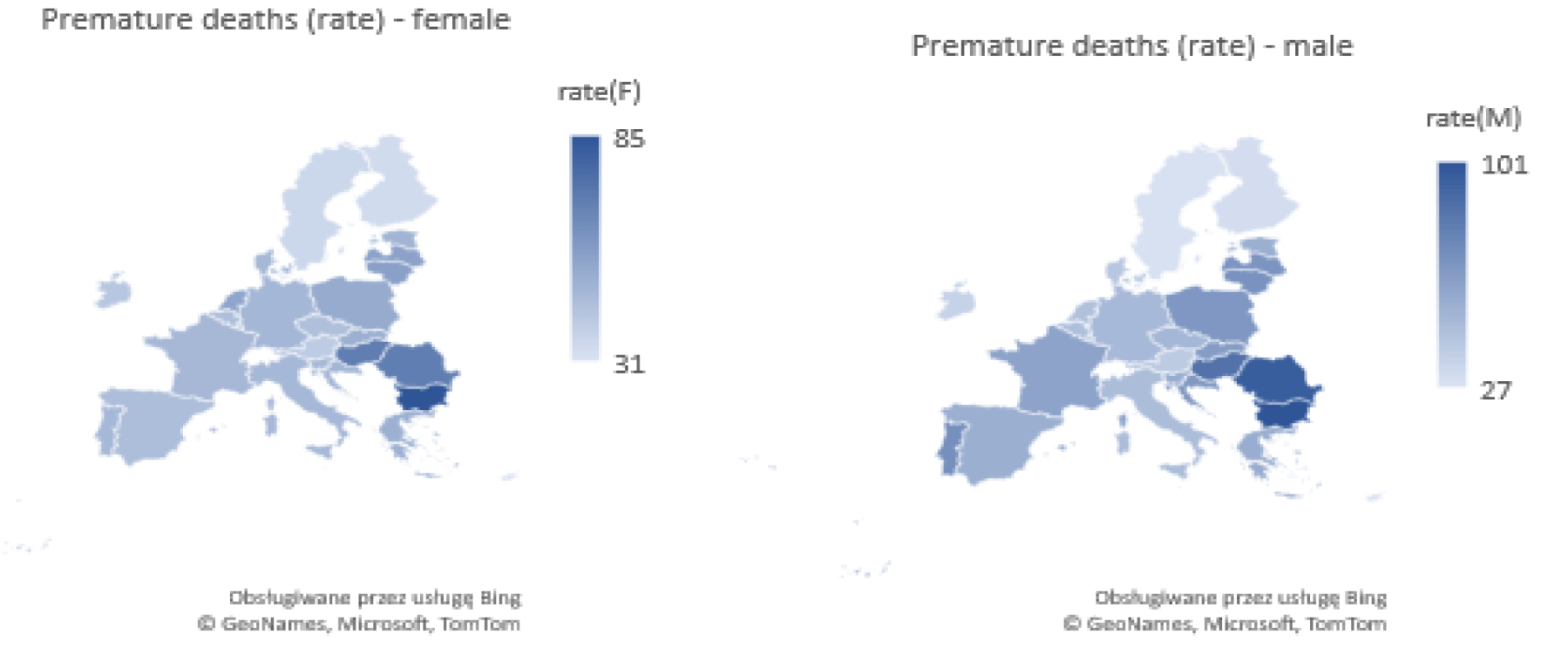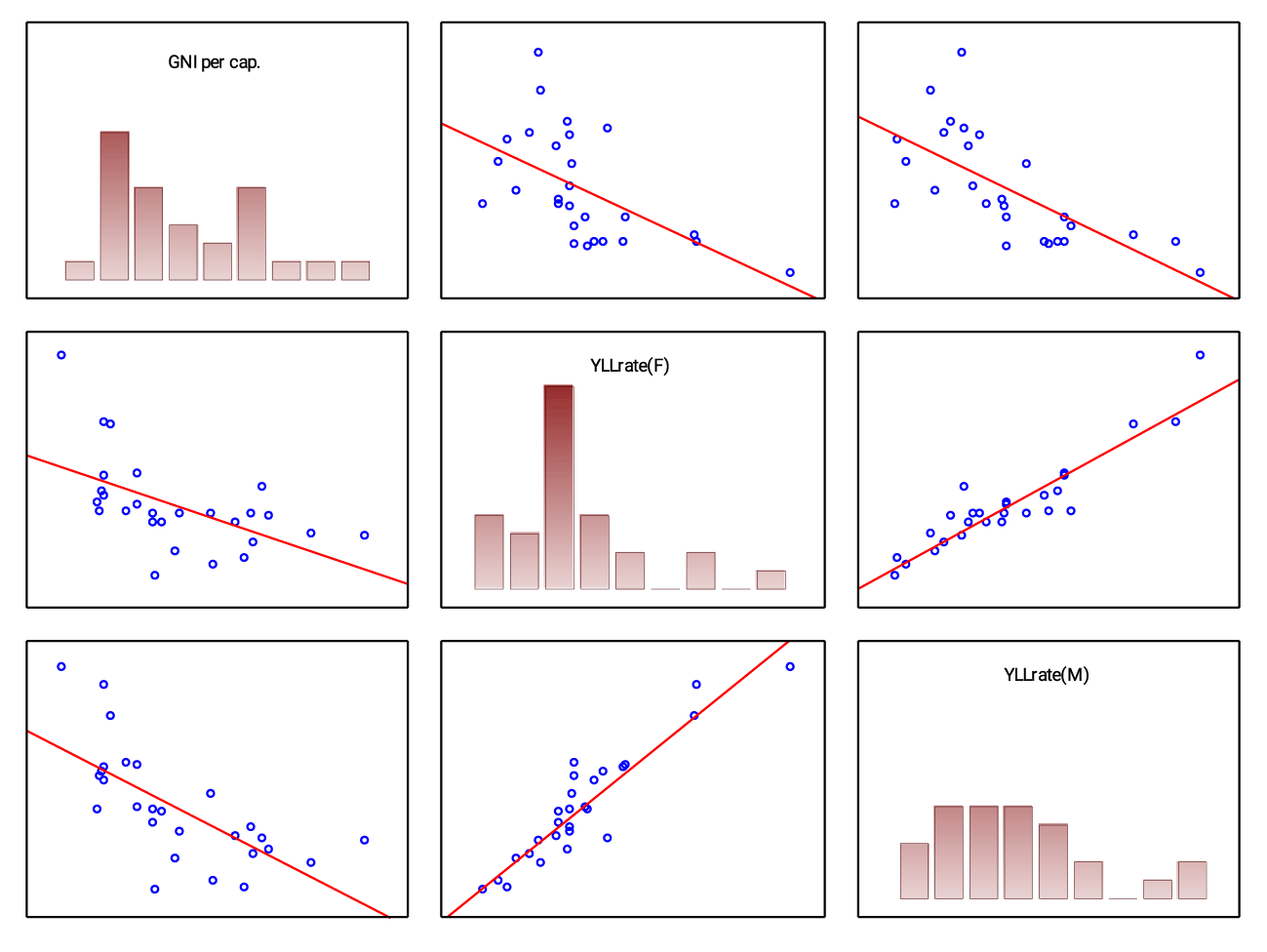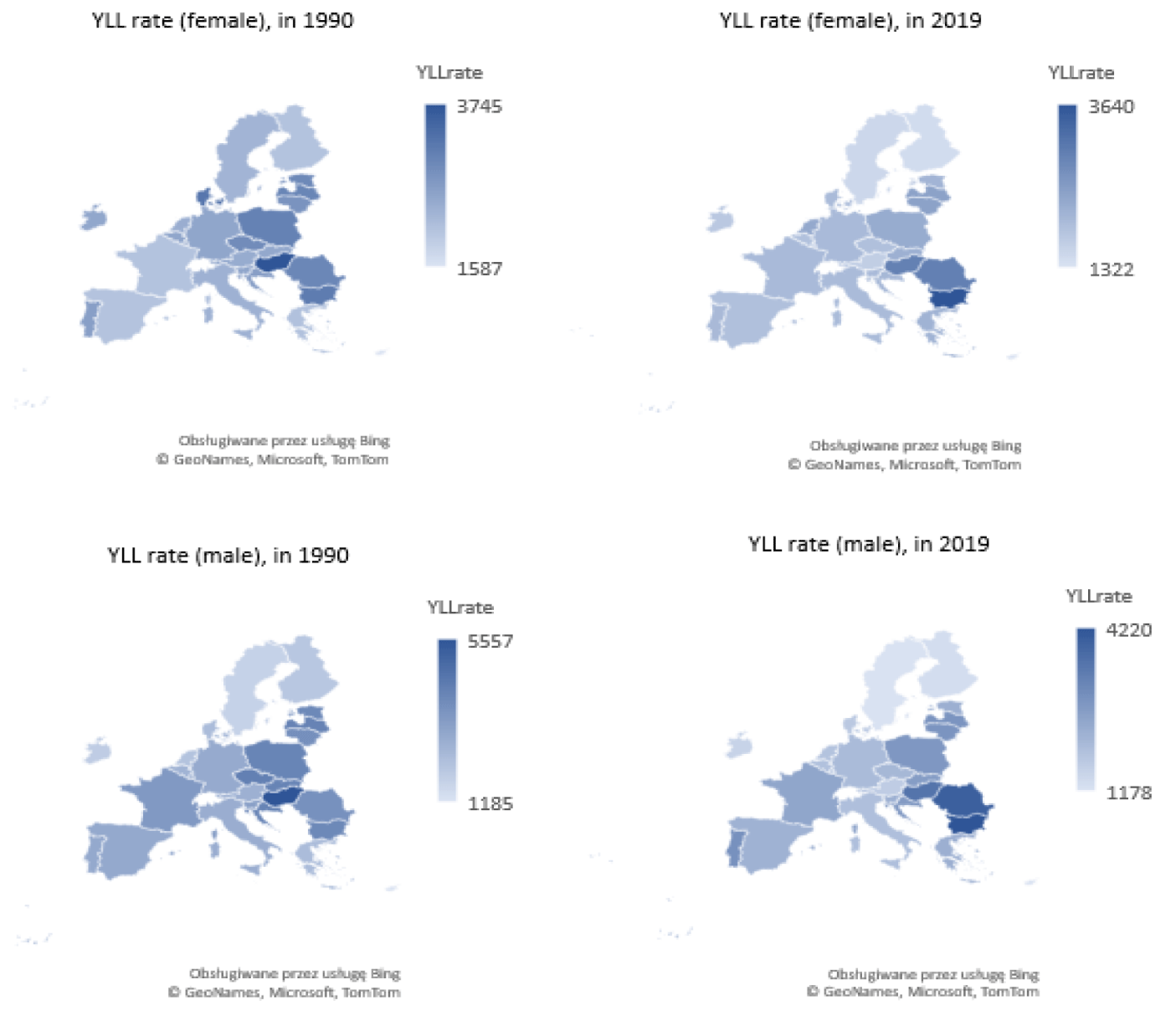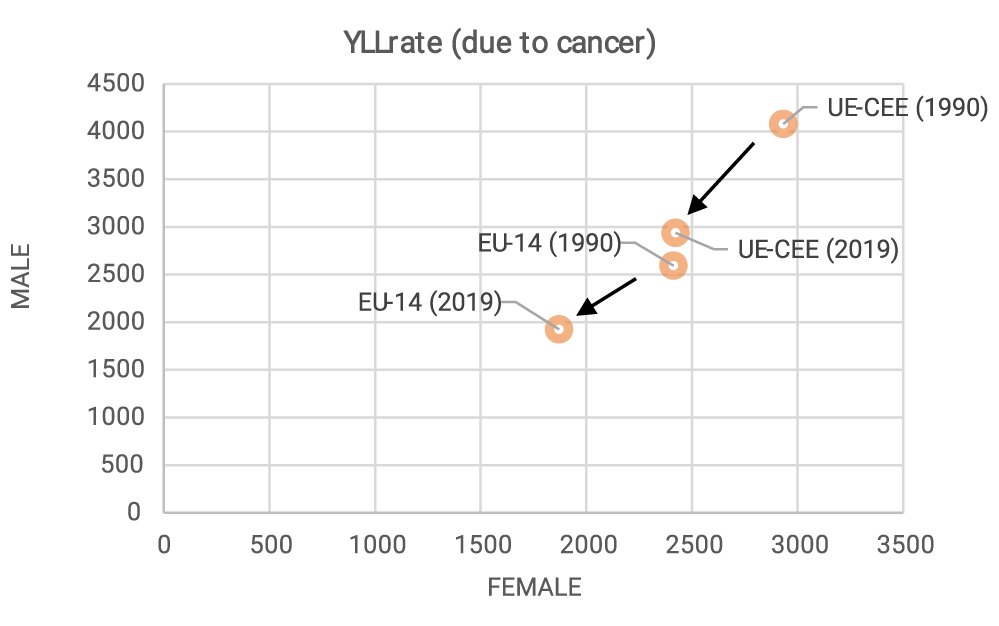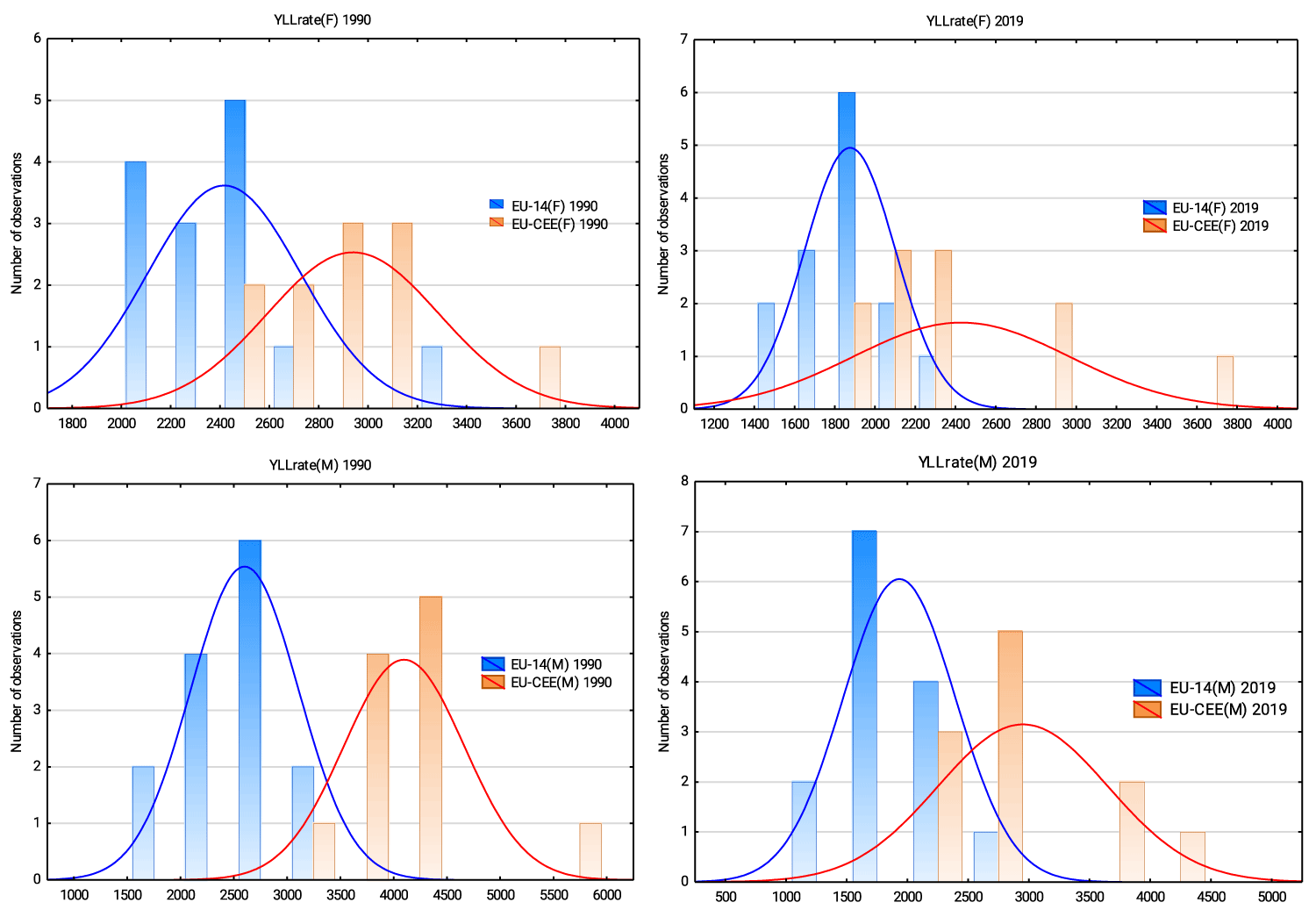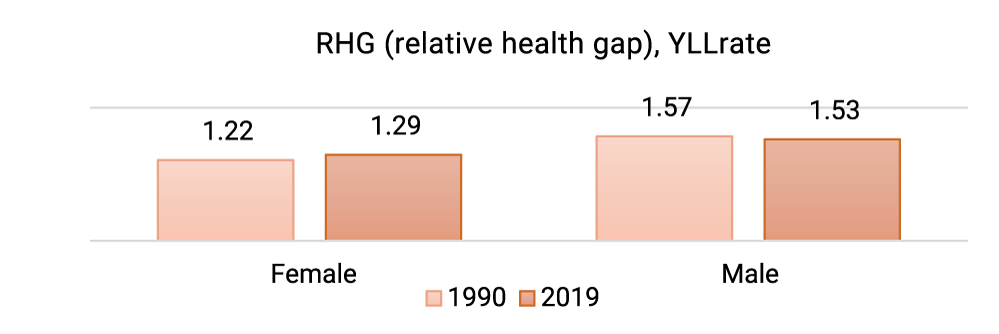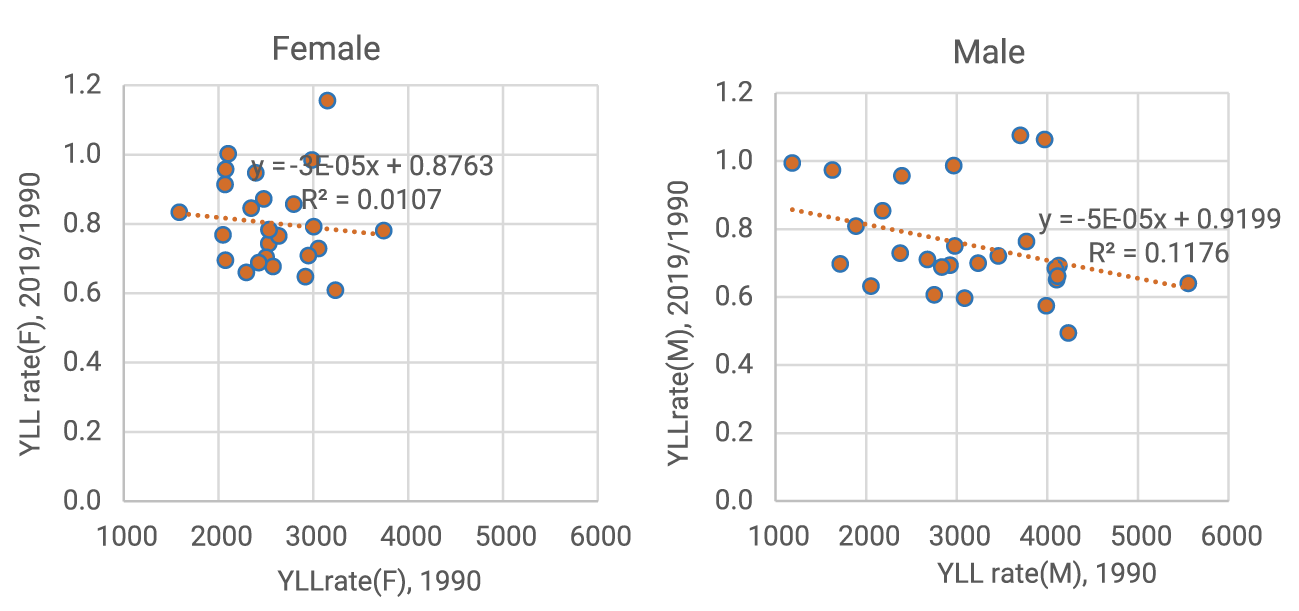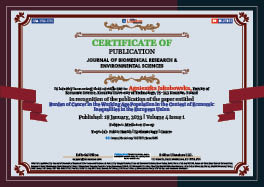Medicine Group . 2023 January 18;4(1):023-036. doi: 10.37871/jbres1645.
Burden of Cancer in the Working Age Population in the Context of Economic Inequalities in the European Union
Agnieszka Jakubowska*
- Neoplastic disease
- Burden of cancer
- Productivity lost
- Inequalities in the EU
Abstract
The aim of the presented research is to assess the degree of burdening the EU economies with the effects of cancer in the context of the limitations diagnosed of the labor market potential in the Member States. Particular attention was paid to the problem of existing inequalities in the level of burdening national economies with the effects of premature mortality due to cancer observed in the relationship between the "old" and the "new" EU. The extent to which EU economies were burdened by the long-term effects of cancer was measured by the number of prematurely lost years of healthy life for people of working age. The hypothesis of a persistently high level of inequality was verified on the basis of an analysis of the convergence process in the group of EU-27 countries in the years 1990-2019. The results obtained indicate that the level of health limitations caused by cancer is strongly differentiated in the EU-27 group. The inequalities observed concern, in particular, the relationship between the "old" and "new" Europe and indicate a high burden of health consequences for the inhabitants of Central and Eastern Europe. The analysis of catching up process by the countries with the least favorable situation (the highest level of cancer burden), carried out in the EU-27 group, did not show a real effect of reducing disproportions in the level of the parameters analyzed.
Introduction
Cancer is a major contributor to the global burden of disease [1,2], and projections predict that the global burden of cancer will continue to increase [3-5]. Among the Member States of the European Union, there is currently a high differentiation of the burden of cancer diseases. It is determined by differences in the incidence of individual diseases, as well as in the level of their mortality [6-8]. This results in a significant level of disproportion in the life expectancy in health between the inhabitants of the EU countries [9-11], and as a consequence, it fundamentally determines the potential productivity of the labor resources of individual economies [12-15]. The estimates by the World Health Organization (WHO) indicate that in the EU countries, cancer is currently responsible for almost 30% of all deaths and 34% of prematurely lost potential years of life [16]. A similarly high level of burden is also observed in the group of people of working age. This indicates that cancer and its long-term consequences have a significant impact on the potential of human resources in EU economies. In this context, cancer is a serious public health problem, but at the same time it determines the production capacity of the entire economy.
The aim of the presented study is to assess the scale of burdening EU economies with the consequences of cancer in the context of the limitations diagnosed of the labor market potential in the Member States. The potential of lost labor resources is presented by means of indicators determining the number of years of healthy life lost as a result of chronic diseases of working age people. Particular attention was paid to the problem of inequalities in the level of burdening economies with the effects of chronic diseases observed in the relationship between the "old" and the "new" Union. In this context, the convergence process taking place between the EU-27 countries in terms of leveling the initial disproportions in burdening the potential productivity of the economy was assessed. The scale of the long-term impact of cancer on EU economies is expressed in the rates of Years of Life Lost to disease as a result of premature death (YLL) or disability (YLD) based on Institute for Health Metrics and Evaluation (IHME) data from the Global Burden of Disease Study 2019 [17].
In highly developed countries, an increase in chronic diseases, including cancer, is observed in increasingly younger populations. These diseases are characterized by both high mortality and a significant degree of disability, limiting the possibilities of effective life and work of people of working age [18-21]. Poor health is currently indicated as one of the main causes of occupational deactivation of labor resources [22-25], and the relationship between the state of health of the society and its productivity is becoming the subject of an increasing number of studies [26-29]. The growing problem of employees' absence for health reasons (absenteeism) or their reduced productivity due to ill health (presenteeism) forces employers to use mechanisms to ensure the continuity of production processes [30-33].
It is estimated that in 2019 around the world, cancer was responsible for the loss of 250 million (95% UI, 235-264 million) years of healthy life, of which as much as 96.9% (95% UI, 96.0%-97.7%) was due to premature death. Cancer was the second leading cause of premature death after cardiovascular disease. From 2010 to 2019, the number of new cancer cases and deaths globally increased by 26.3% (cases) and 20.9% (deaths) [34]. The main risk factors that contributed to the global burden of cancer in 2019 were behavioral factors, however, in 2010-2019, the share of metabolic risk factors for cancer increased the most. In 2019, cancer risk factors were responsible for 4.45 million (95% UI, 4.01-4.94) deaths and 105 million (95% UI, 95.0-116) Disability-Adjusted Life Years (DALYs). This represents 44.4% (95% UI, 41.3-48.4) of all cancer deaths, and 42.0% (95% UI, 39.1-45.6) of all DALYs [35]. The Global Burden of Disease Study data points to a significant and increasing global burden of cancer, noting that patterns of burden vary according to the level of socioeconomic development in an area. It is estimated that in countries with a high rate of socio-economic development, cancer overtook cardiovascular diseases, becoming the main cause of loss of years of life and health worldwide [34]. There are also large differences in cancer survival between European countries [36].
Taking into account the high rates of morbidity and the high number of deaths, cancer should therefore also be seen in the context of a significant reduction in the productive potential of people affected by this disease. Although labor productivity has become an important outcome of cost-of-illness studies, there are relatively few studies that compare the impact of common chronic diseases on decline in labor productivity across samples of the general population. Cancer survivors often recover from cancer, however studies show that at least one-third of cancer survivors leave the workforce altogether within 6 months immediately after diagnosis [37]. Upon returning to work, these individuals often report work-related limitations that prevent them from performing at pre-illness levels [38].
Guy GP, et al. [39] based on a review of the literature on the possibility of premature death and the indirect costs of cancer, found that despite the observed heterogeneity of studies, including the studied populations and the research methods used, the estimated potential lost productivity significantly affects the productivity of the economy. An assessment of the costs of sickness absence due to cancer in Poland, carried out by Macioch T, et al. [32] showed that the indirect costs of lost productivity due to cancer, i.e. related sick leave, disability and premature death, have a significant impact on the Polish economy.
Bradley CJ, et al. [40] developed a model that predicts the economic benefits of reduced cancer mortality provides critical information on how to allocate scarce resources to interventions with the greatest benefit. This model uses a human capital approach that relies on wages as a measure of productivity to estimate the value of lost productivity due to cancer mortality. The estimated annual cost of lost productivity in the United States due to cancer mortality in the base model was approximately $115.8 billion in 2000; the projected value was $147.6 billion for 2020. Lung cancer deaths accounted for more than 27% of productivity costs. Sensitivity analyzes conducted by these scientists showed that reducing mortality from lung, colorectal, breast, leukemia, pancreatic and brain cancers by 1% per year reduced productivity costs by $814 million per year (2000-2020 estimates). Including income foregone for care and domestic activities increased the total cost of productivity in the base model to $232.4 billion in 2000 and $308 billion in 2020.
Luengo-Fernandez R, et al. [41] obtained regression results suggest that a €1 billion increase in cancer-related healthcare spending in the EU would result in a reduction of 640 cancer-related deaths. However, this relationship was weak and insignificant. Indeed, this relationship appears to be skewed by a nation's income or wealth (as measured by gross domestic product per capita), with income affecting both cancer-related healthcare costs (positive correlation) and mortality (negative correlation). It should be noted, however, that survival and mortality are complex outcomes of various input factors, and funding is only one of them. These researchers point out that the most important single-factor predictor of increased cancer healthcare spending may be national income per capita (as measured by gross domestic product), but even within countries with the same national income, cancer healthcare spending varies widely—for example, the per capita gross domestic product of Germany and the UK was similar in 2009, but Germany spent twice as much on cancer-related healthcare as the UK per capita (€171 versus €92, adjusted for price differences).
Materials and Methods
The analysis of the burden of chronic diseases on EU economies was carried out using indicators of the number of Years of Life Lost as a result of premature death (YLLs) and the number of potential Years of Life with a Disability (YLDs) in the working age group. The selection of the variables analyzed was made on the basis of a review of the methodology for evaluating the studied phenomenon proposed in the literature [42,43]. These measures are intended to illustrate the potentially lost time of effective work provided by working age people, at the same time indicating the level of burden of national economies with the effects of chronic diseases. Taking into account the adopted context of the study, the level of burdening in the 20-54 age group was analyzed, recognizing this age group as the most productive. Comparability of data between EU Member States was obtained using intensity indicators relating the number of observed cases to a specific size of the population - YLLrate, YLDrate. The scale of the dispersion of the parameters analyzed at the level of the EU-27 countries and in relation to the analyzed groups of countries was determined using statistical measures. For the purpose of the planned assessment of inequalities in the level of burden of the EU economies with the effects of cancer diseases of the working age population, observed in relation to the "old" and "new" EU countries, two groups were distinguished: (1) EU-14 countries representing highly developed economies with market traditions admitted to the EU before 2004 and (2) EU-CEE countries of Central and Eastern Europe admitted to the EU structures after 2004 with experience of political transformation.
The assessment of the level of inequality in the process analyzed was based on the use of the RHG index (relative health gap), which allows to determine the statistical level of "chance" for the occurrence of negative consequences of cancer (premature death or loss of health) of inhabitants of Central and Eastern Europe in relation to people living in the "old" Union. The estimation of the relative difference (RHG) in the level of burden of consequences of chronic diseases determining the level of inequality between the study groups was made using the following formula:
In the assumed study, h(A) is a measure of the health burden for group A, while h(B) is an analogous measure for group B.
Before the substantive assessment of the examined inequalities, a statistical assessment of the significance of the observed differences in the parameters analyzed between the groups of EU-27 countries was carried out. For the purposes of the study, it was hypothesized that belonging to particular groups of EU countries has a significant impact on the level of health burden of cancer in people of working age. As a result, there are statistically significant differences between the EU-14 and EU-CEE study groups in terms of the average level of years of potentially productive life lost due to cancer, but ongoing European integration processes have reduced the observed differences over time. The expected effect of decreasing inequalities in the level of burdening EU-27 economies with the consequences of cancer diseases will be a visible convergence process involving a decrease in the average level of the studied indicators over time along with a reduction in their dispersion.
An appropriate test scheme was adopted to examine the statistical significance of the assessed differences between the average levels of the studied variables in selected EU groups. On the basis of the assessment of the normality of the distribution of the examined variables (Shapiro-Wilk test), a scheme for testing the significance of differences was selected, assuming that in the case of confirming the normality of the distribution of variables, the Brown-Forsyth test will be used to assess the homogeneity of the distribution of variances for the tested independent samples. In the case of finding homogeneity of variances, the Student's t-test was used, while in the case of significant differences in the variances of the variables analyzed, the Welch test was used, which is a modification of the Student's t-test. In the absence of confirmation of the normality of the distribution, the non-parametric Mann-Whitney test was used to assess differences in the average level of variables between the studied groups of countries. The null hypothesis was rejected when the test probability p was below the assumed test significance level α = 0.05. The calculations were performed in the Statistica 13 program.
In assessing the system's search for equilibrium, the concept of conditional beta convergence was used, which takes into account different initial conditions and provides for faster catching up of average values by outliers with respect to the target, and the concept of sigma convergence, defined as reducing the dispersion of achieved results. The analysis assumes that beta convergence takes place in the study area if countries with an initially worse value of a given variable (the highest level of lost years of life) catch up with the system, showing a faster pace of transition to the expected state. The occurrence of sigma type convergence means that the expected decrease in the degree of dispersion of the feature examined (CV - coefficient of variation) has been achieved over time.
Preliminary analysis of data on the level of burden of consequences of chronic diseases shows that in the case of the surveyed age group of 20-54, the main consequence of cancer is premature death of people affected by this disease. According to the data of the Institute of Metrics and Health Assessment [17] on the burden of chronic diseases in global economies, depending on the Member State, in 2019 the total number of years of life and health lost due to cancer among EU residents aged 20-54 was 2.57 million women and 2.79 million men. In this number, years of healthy life lost as a result of disability (YLD) amounted to 6.2% for women and 3.8% for men (Figure 1). The key problem of burdening the potential of people of working age is therefore the high mortality rate of people affected by cancer. Considering the above, this analysis focuses on the burden of Lost Years of Life (YLL), considering it as a significant reduction in the productive potential of these economies as a result of cancer.
A preliminary analysis of the distribution of the burden of cancer in particular age groups (Figure 2) indicate an increase in this burden with age. While in the younger age groups (30-44) premature death burdens women to a greater extent, in the population aged 45-54 the burden of premature death is higher in the group of women. The distribution of Years of Life Lost due to cancer (YLL rate) in the group of women and men aged 20-54 is presented in figure 2.
The analysis of links between EU economies in terms of cancer burden indicates the existence of a relationship between the economic situation of a given country and the health outcomes of its inhabitants. Significantly worse parameters of cancer survival are observed in the group of EU countries of Central and Eastern Europe with the experience of political transformation. In terms of premature death from cancer, these countries form the worst-performing group (Figure 3).
The assessment of the relationship between the level of socio-economic development of the country and the level of premature death of its inhabitants due to cancer confirms the existence of a relatively strong relationship between the indicated parameters observed in the group of EU-27 countries (Table 1). In the case of EU countries, there is a clear correlation between the level of economic development of the country measured by the value of national income (GIN) per capita and the indicator of the number of Years of Life Lost (YLLrate) as a result of cancer in people of working age. The presented relations confirm the unfavorable patterns observed in the group of European Union countries-inhabitants of countries with lower incomes can statistically expect a higher number of premature deaths due to cancer.
| Table 1: Correlation coefficients-YLLrate (due to cancer), GNI per capita, population aged 20-54 (EU-27, in 2019). | |||||
| Parameters | Mean | Standard Deviation |
GNI per cap. | YLLrate(F) | YLLrate(M) |
| Correlation Coefficients | |||||
| GNI per cap. | 30207 | 9164 | 1.00 | -0.55 | -0.69 |
| YLLrate(F) | 2065 | 490 | -0.55 | 1.00 | 0.92 |
| YLLrate(M) | 2297 | 781 | -0.69 | 0.92 | 1.00 |
| Marked correlation coefficients are significant at p < 0.05000, n = 27, F: Female; M: Male | |||||
| Source: Own study based on the data from Global Burden of Disease Study 2019 (GBD 2019) Results. Seattle, United States: Institute for Health Metrics and Evaluation (IHME), 2020. Available from https://vizhub.healthdata.org/gbd-results/ (YLLrate) and Eurostat date, http://ec.europa.eu/eurostat (GNI per cap.). | |||||
Estimated correlation indicators between the burden of cancer consequences and the level of economic development of a given country confirm a relatively high level of correlation between these parameters (Table 1). The correlation coefficient between the level of national income (GNI) per capita and the indicator of Years of Life Lost due to cancer (YLLrate) of people aged 20-54 in the group of EU-27 countries was -0.55 for women and -0.69 for men with statistical significance of p < 0.05. At the same time, the obtained results indicate a strong relationship between the number of years of life lost by men and women as a result of cancer (r = 0.92). The relationships of individual variables in the form of a correlation matrix are shown in figure 4.
Results
The burden of the consequences of cancer, estimated at the level of national economies, expressed in the number of years of potentially healthy life lost by people of working age as a result of premature death, indicates the existence of significant differences in the scale of this phenomenon in relation to individual EU-27 Member States. In 2019, in the group of EU countries, the cancer burden rate causing premature death (YLLrate) in the group of people aged 20-54 was on average 2065 (women) and 2297 (men) years of prematurely lost life per 100,000 people at this age. For the studied EU-27 economies, the YLL index ranged from 1322 (Cyprus) to 3640 (Bulgaria) for women and from 1178 (Cyprus) to 4220 (Bulgaria) for men. In the years 1990-2019, the average level of YLLrate decreased by 20% in the group of women and by 26% in the group of men. With regard to the group of EU-27 countries, this change means a decrease in the average cancer burden in the population aged 20-54 by 516 prematurely lost years of life per 100,000 people (YLLrate). This proves a positive trend in this regard observed in the surveyed group of countries and applies to most EU-27 countries (Table 2). Only Bulgaria (an increase of 16% for women and 6% for men) and Romania (an increase was 8% for men) recorded an increase in addiction. The largest reductions in the burden of premature mortality due to cancer were achieved for women in Denmark (a decrease YLLrate was 39%) and men in the Czech Republic (a decrease YLLrate was 51%).
| Table 2: Number of years lived with disability (YLLs) due to cancer, per 100,000 people aged 20-54 (EU-27 countries, in 2019 and change in 1990-2019). | ||||||||||||
| EU Member States | Groups of EU | Female | Male | |||||||||
| YLL Rate (2019) | Percentage Change 1990-2019 |
Rankings | YLL Rate (2019) | Percentage Change 1990-2019 |
Rankings | |||||||
| 2019 | 1990 | 2019 | 1990 | |||||||||
| Bulgaria | EU-CEE | 3640 | 16% | 1 | 3 | 4220 | 6% | 1 | 8 | |||
| Romania | EU-CEE | 2941 | -2% | 2 | 6 | 3981 | 8% | 2 | 10 | |||
| Hungary | EU-CEE | 2922 | -22% | 3 | 1 | 3554 | -36% | 3 | 1 | |||
| Lithuania | EU-CEE | 2396 | -14% | 4 | 9 | 2875 | -24% | 5 | 9 | |||
| Latvia | EU-CEE | 2381 | -21% | 5 | 5 | 2856 | -31% | 6 | 3 | |||
| Netherlands | EU-14 | 2269 | -5% | 6 | 19 | 1863 | -15% | 19 | 22 | |||
| Poland | EU-CEE | 2227 | -27% | 7 | 4 | 2797 | -32% | 7 | 6 | |||
| Slovakia | EU-CEE | 2161 | -13% | 8 | 17 | 2670 | -35% | 9 | 5 | |||
| Greece | EU-14 | 2108 | 0% | 9 | 22 | 2289 | -4% | 12 | 20 | |||
| Estonia | EU-CEE | 2088 | -29% | 10 | 7 | 2290 | -43% | 11 | 7 | |||
| Croatia | EU-CEE | 2017 | -24% | 11 | 10 | 2719 | -34% | 8 | 4 | |||
| Portugal | EU-14 | 2005 | -23% | 12 | 11 | 2926 | -1% | 4 | 15 | |||
| France | EU-14 | 1988 | -4% | 13 | 23 | 2493 | -28% | 10 | 11 | |||
| Slovenia | EU-CEE | 1984 | -22% | 14 | 13 | 2264 | -30% | 13 | 12 | |||
| Germany | EU-14 | 1984 | -22% | 15 | 14 | 2029 | -31% | 16 | 16 | |||
| Italy | EU-14 | 1981 | -16% | 16 | 20 | 1951 | -31% | 17 | 17 | |||
| Denmark | EU-14 | 1967 | -39% | 17 | 2 | 1730 | -27% | 21 | 21 | |||
| Spain | EU-14 | 1892 | -9% | 18 | 25 | 2234 | -25% | 14 | 14 | |||
| Czechia | EU-CEE | 1889 | -35% | 19 | 8 | 2090 | -51% | 15 | 2 | |||
| Belgium | EU-14 | 1881 | -26% | 20 | 15 | 1901 | -29% | 18 | 19 | |||
| Ireland | EU-14 | 1762 | -30% | 21 | 16 | 1525 | -19% | 24 | 24 | |||
| Luxembourg | EU-14 | 1744 | -32% | 22 | 12 | 1841 | -40% | 20 | 13 | |||
| Austria | EU-14 | 1669 | -31% | 23 | 18 | 1669 | -39% | 22 | 18 | |||
| Malta | - | 1575 | -23% | 24 | 26 | 1585 | -3% | 23 | 26 | |||
| Sweden | EU-14 | 1514 | -34% | 25 | 21 | 1195 | -30% | 26 | 25 | |||
| Finland | EU-14 | 1442 | -31% | 26 | 24 | 1298 | -37% | 25 | 23 | |||
| Cyprus | - | 1322 | -17% | 27 | 27 | 1178 | -1% | 27 | 27 | |||
| Selected Statistics | ||||||||||||
| Average | EU-27 | 2065 | -20% | 2297 | -24% | |||||||
| Interval | 2318 | 3042 | ||||||||||
| Average | EU-14 | 1872 | -22% | 1925 | -26% | |||||||
| Interval | 827 | 1732 | ||||||||||
| Average | EU-CEE | 2422 | -18% | 2938 | -27% | |||||||
| Interval | 1751 | 2130 | ||||||||||
| Source: Own study based on the data from Global Burden of Disease Study 2019 (GBD 2019) Results. Seattle, United States: Institute for Health Metrics and Evaluation (IHME), 2020. Available from https://vizhub.healthdata.org/gbd-results/. | ||||||||||||
The analysis of the spatial distribution of the burden of cancer consequences in the population aged 20-54 indicates a particularly high risk of negative effects in relation to the EU countries of Central and Eastern Europe, observed both in the group of women and men (Figure 5). For this group of countries, the rates of years of life lost as a result of premature death from cancer are much higher than in other EU countries. At the same time, noticeable differences between groups of EU countries persisted throughout the period analyzed of 1990-2019.
Despite disproportions in the burden of cancer consequences between the groups, the average rate of decline in the YLLrate after 1990 in the group of Central and Eastern European countries did not differ significantly from that observed in the same period in the EU-14 group. For women in the EU-CEE group, the average rate of decline was 18%, compared to 22% in the EU-14 group. For men in the EU-CEE group, the average rate of decline was 27%, compared to 26% in the EU-14 group. This indicates that the disproportions persist in the examined range (Table 1).
In order to confirm the measurability of the differences observed between the groups studied, the statistical significance was assessed. Based on the assessment of the normality of the distribution of the variables studied (the Shapiro-Wilk test), a scheme for testing the significance of differences was selected. When the normality of the distribution of variables was confirmed (parameter YLLrate(M)2019), the t-test was used to assess the significance of the distribution of differences for the independent samples tested or when the variances of the variable analyzed differed significantly, the Welch's test was used. For the variables for which the normality of the distribution was not confirmed (parameters YLLrate(F)1990, YLLrate(F)2019, YLLrate(M)1990), the non-parametric Mann-Whitney test was used to evaluate the differences. The values obtained of the test probability p (for α = 0.05) allowed for the rejection of the null hypothesis in all the cases, which means that the differences in the mean levels of all the parameters examined are statistically significantly different. The obtained test results are presented in the tables 3,4.
| Table 3: Parameters of a normal distribution. | ||||||||
| Parameters | Mean EU-14 |
Mean EU-CEE |
t-test | Brown-Forsythe test | ||||
| t | df | p | Brn-Fors F(1.df) |
df Brn-Fors |
p Brn-Fors |
|||
| YLLrate(M) 2019 | 1924.582 | 2937.794 | -4.36827 | 23 | 0.000225 | 1.0107 | 23 | 0.3252 |
| Source: Own evaluation. | ||||||||
| Table 4: Parameters of a non normal distribution. | |||||||
| Parameters | Mann-Whitney U test | ||||||
| Sum.rang EU-14 |
Sum.rang EU-CEE |
U | Z | p | Z correc. |
p | |
| YLLrate(F) 1990 | 122.0000 | 203.0000 | 17.00000 | -3.25732 | 0.001125 | -3.25732 | 0.001125 |
| YLLrate(F) 2019 | 123.0000 | 202.0000 | 18.00000 | -3.20258 | 0.001362 | -3.20258 | 0.001362 |
| YLLrate(M) 1990 | 106.0000 | 219.0000 | 1.00000 | -4.13324 | 0.000036 | -4.13324 | 0.000036 |
| Source: Own evaluation. | |||||||
The observations presented above confirm that the burden of cancer diseases on the EU-CEE economies significantly exceeds the level recorded in the "old" EU countries. In the case of the analyzed cancers, the burden of prematurely lost years of life among people of working age was significantly higher in the group of EU countries in Central and Eastern Europe. This proves that the gap existing in this respect in 1990 did not decrease significantly in the period analyzed, including the period of integration of the "new" EU into the structures of the European community. A summary of the results for both groups of member states is presented in figure 6, which also shows the path of “catching up” with the countries of Central and Eastern Europe with highly developed Western economies.
The indicated downward trends in parameters in both groups over time have a positive impact on the global level of the burden of health effects of cancer in the EU. However, too low a rate of decline in the examined parameters in the group of EU-CEE countries (initially occupying a worse position) compared to the EU-14 countries causes that the observed disproportions persist over time (Figure 7).
The degree of differentiation of the scale of burdening the economies of the EU countries with the consequences of cancer diseases is evidenced by the estimated “relative health gap” of the RHG in the context of old and new EU countries. This made it possible to determine the scale of existing inequalities in this area. The results of the RHG(YLL) index indicate that the so-called the “chance” of a resident of the EU-CEE area aged 20-54 to be burdened with the negative effects of cancer (premature death) is relatively greater than in the case of an inhabitant of the EU-14 area. In 2019, the RHG index in the group of women was 1.29 and in the group of men 1.53. At the same time, the obtained results indicate that the level of inequality in the period analyzed of 1990-2019 has not changed significantly. In 1990, the RHG index was 1.22 for women and 1.57 for men (Figure 8).
The assessment of the convergence process taking place in the group of EU-27 countries in the area of health and the related expected reduction of disproportions in the scale of the negative impact of cancer on the burden of working-age people was based on the assessment of the change in time of the YLL indicator, which defines the number of years of life lost per 100 thousand people. Assuming different initial conditions for individual EU countries, determined by the level of the variable YLLrate in 1990, the rate of change of the parameters analyzed in individual countries over the years 1990-2019 was determined (relation 2019/1990). It was assumed that in the case of Member States with difficult initial conditions (high YLLrate), this relationship should be as low as possible (approaching 0), indicating a sharp decrease in the parameter analyzed, resulting in catching up with the group (convergence beta). The results obtained for the burden of the consequences of cancer diseases separately for the group of women and men are presented in figure 9.
The obtained results of beta convergence indicate that in the case of the YLL coefficient, which determines the number of prematurely lost years of life due to cancer, a large dispersion of variables in both groups (men and women) indicates the lack of significant convergence effects within the EU-27. The analysis of changes in the degree of dispersion of the examined indicators in the period 2000-2019 (sigma convergence) confirmed the persisting and even increasing level of differentiation of the examined parameters in both groups over time (Figure 10). This indicates that the disparities between the countries under study are not decreasing, and the high inequalities in the burden on national economies caused by premature deaths of people of working age affected by cancer are still high. The expected effects of convergence bringing the outlier economies (in this case, the countries of Central and Eastern Europe) closer to the average values observed in the EU-27 are not visible.
Conclusion
Diseases and their long-term effects are currently an important factor determining the level of productivity of labor resources in developed market economies, which means that investments in health capital, next to knowledge capital, should be treated as one of the most important activities increasing the effectiveness of human capital, both at the level of the entire economy, as well as individual enterprises. The results of the analysis of the burden of cancer in the economies of EU countries confirm that this disease is a significant limitation of the potential productivity of labor resources. Long-term consequences of cancer lead to loss of health or life, also for people of working age. At the level of the economies of the EU countries, there is a large diversification of the scale of burdening labor resources with the consequences of chronic diseases, including cancer, which makes it necessary to recognize the specificity of this phenomenon in relation to national conditions. The obtained results confirmed the disproportionately large share of Central and Eastern European countries in this phenomenon. Diagnosed inequalities between the countries of the "old" and "new" EU in the level of burden of people in working age with the consequences of cancer indicate that a significant problem in the EU-CEE countries turned out to be a relatively high mortality rate. The analysis of the process of catching up with the countries with the least favorable situation (i.e. with the highest cancer burden) carried out in the EU-27 group did not show a positive convergence effect in this respect. In the examined system, no real effect of reducing disproportions in the levels of the examined indicators over time was observed. Despite the cohesion policy implemented in the EU, the phenomenon analyzed is still very dispersed. The obtained results go beyond the framework presented so far in the literature on the burden of consequences of cancer diseases and introduce the perspective of existing inequalities in the study area observed between EU economies. Presentation of health determinants in the context of limitations of the potential productivity of labor resources provides the basis for estimating the measurable economic effects of reducing the burden of cancer in the working age population.
The scale of the problem outlined in the presented research, as well as the scope of its effects (loss of health or life) suggest that the issue of possible actions to reduce the existing inequalities in the incidence of cancer and the long-term consequences of cancer should become part of a rational cohesion policy. The obtained results of the assessment of the convergence process taking place among EU countries in terms of health inequalities are a real basis for designing activities in the field of rational public health policy, as well as estimating the economic costs of losing the productivity of human resources. The presented results of the analysis are the author's own contribution to the discussion on the scale, causes and costs of socio-economic health inequalities observed in the context of the old and new EU.
References
- Ma X, Yu H. Global burden of cancer. Yale J Biol Med. 2006 Dec;79(3-4):85-94. PMID: 17940618; PMCID: PMC1994799.
- Popat K, McQueen K, Feeley TW. The global burden of cancer. Best Pract Res Clin Anaesthesiol. 2013 Dec;27(4):399-408. doi: 10.1016/j.bpa.2013.10.010. Epub 2013 Oct 24. PMID: 24267547.
- Thun MJ, DeLancey JO, Center MM, Jemal A, Ward EM. The global burden of cancer: priorities for prevention. Carcinogenesis. 2010 Jan;31(1):100-10. doi: 10.1093/carcin/bgp263. Epub 2009 Nov 24. PMID: 19934210; PMCID: PMC2802672.
- Arnold M, Abnet CC, Neale RE, Vignat J, Giovannucci EL, McGlynn KA, Bray F. Global Burden of 5 Major Types of Gastrointestinal Cancer. Gastroenterology. 2020 Jul;159(1):335-349.e15. doi: 10.1053/j.gastro.2020.02.068. Epub 2020 Apr 2. PMID: 32247694; PMCID: PMC8630546.
- Sung H, Ferlay J, Siegel RL, Laversanne M, Soerjomataram I, Jemal A, Bray F. Global Cancer Statistics 2020: GLOBOCAN Estimates of Incidence and Mortality Worldwide for 36 Cancers in 185 Countries. CA Cancer J Clin. 2021 May;71(3):209-249. doi: 10.3322/caac.21660. Epub 2021 Feb 4. PMID: 33538338.
- Hanly P, Koopmanschap M, Sharp L. Valuing productivity costs in a changing macroeconomic environment: the estimation of colorectal cancer productivity costs using the friction cost approach. Eur J Health Econ. 2016 Jun;17(5):553-61. doi: 10.1007/s10198-015-0698-5. Epub 2015 May 29. PMID: 26022915.
- Forsea AM. Melanoma Epidemiology and Early Detection in Europe: Diversity and Disparities. Dermatol Pract Concept. 2020 Jun 29;10(3):e2020033. doi: 10.5826/dpc.1003a33. PMID: 32642304; PMCID: PMC7319793.
- Forsea AM. Cancer registries in Europe-going forward is the only option. Ecancermedicalscience. 2016 May 12;10:641. doi: 10.3332/ecancer.2016.641. PMID: 27350787; PMCID: PMC4898937.
- Fouweather T, Gillies C, Wohland P, Van Oyen H, Nusselder W, Robine JM, Cambois E, Jagger C; JA: EHLEIS Team. Comparison of socio-economic indicators explaining inequalities in Healthy Life Years at age 50 in Europe: 2005 and 2010. Eur J Public Health. 2015 Dec;25(6):978-83. doi: 10.1093/eurpub/ckv070. Epub 2015 Apr 14. PMID: 25876883.
- Van Oyen H, Nusselder W, Jagger C, Kolip P, Cambois E, Robine JM. Gender differences in healthy life years within the EU: an exploration of the "health-survival" paradox. Int J Public Health. 2013 Feb;58(1):143-55. doi: 10.1007/s00038-012-0361-1. Epub 2012 May 22. PMID: 22618297; PMCID: PMC3557379.
- Minagawa Y. Inequalities in healthy life expectancy in Eastern Europe. Population and Development Review. 2013;39(4):649-671. doi: 10.1111/j.1728-4457.2013.00632.x.
- Jakubowska A, Horváthová Z. Economic growth and health: A comparative study of the EU Countries. Economics and Sociology. 2016;9(3). doi: 10.14254/2071-789X.2016/9-3/14.
- Suhrcke M, McKee M, Stuckler D, Sauto Arce R, Tsolova S, Mortensen J. The contribution of health to the economy in the European Union. Public Health. 2006 Nov;120(11):994-1001. doi: 10.1016/j.puhe.2006.08.011. Epub 2006 Oct 4. PMID: 17027052.
- Ortega-Ortega M, Hanly P, Pearce A, Soerjomataram I, Sharp L. Paid and unpaid productivity losses due to premature mortality from cancer in Europe in 2018. Int J Cancer. 2022 Feb 15;150(4):580-593. doi: 10.1002/ijc.33826. Epub 2021 Nov 2. PMID: 34569617.
- Hanly P, Soerjomataram I, Sharp L. Measuring the societal burden of cancer: the cost of lost productivity due to premature cancer-related mortality in Europe. Int J Cancer. 2015 Feb 15;136(4):E136-45. doi: 10.1002/ijc.29105. Epub 2014 Sep 4. PMID: 25066804.
- WHO. Global Health Estimates: Life expectancy and leading causes of death and disability. 2019.
- Global Burden of Disease Collaborative Network. Global Burden of Disease Study 2019 (GBD 2019) Results. Seattle, United States: Institute for Health Metrics and Evaluation (IHME). 2020.
- Gol-Montserrat J, del Burgo MLM, Quecedo L, del Llano JE. Analysis of productivity costs in cancer: A systematic review. Global & Regional Health Technology Assessment. 2017;4(1). doi: 10.5301/grhta.5000262.
- Bartley M, Sacker A, Clarke P. Employment status, employment conditions, and limiting illness: prospective evidence from the British household panel survey 1991-2001. J Epidemiol Community Health. 2004 Jun;58(6):501-6. doi: 10.1136/jech.2003.009878. PMID: 15143119; PMCID: PMC1732781.
- Haan P, Myck M. Dynamics of health and labor market risks. J Health Econ. 2009 Dec;28(6):1116-25. doi: 10.1016/j.jhealeco.2009.09.001. Epub 2009 Sep 19. PMID: 19818519.
- Aghion P, Howitt P, Murtin F. The relationship between health and growth: when Lucas meets Nelson-Phelps. National Bureau of Economic Research. 2010;w15813:94-126. doi: 10.3386/w15813.
- Blinder VS, Gany FM. Impact of Cancer on Employment. J Clin Oncol. 2020 Feb 1;38(4):302-309. doi: 10.1200/JCO.19.01856. Epub 2019 Dec 5. PMID: 31804857; PMCID: PMC6992498.
- Rice NE, Lang IA, Henley W, Melzer D. Common health predictors of early retirement: findings from the English Longitudinal Study of Ageing. Age Ageing. 2011 Jan;40(1):54-61. doi: 10.1093/ageing/afq153. PMID: 21148324.
- Rodriguez-Alvarez A, Rodriguez-Gutierrez C. The impact of health on wages: evidence for Europe. Eur J Health Econ. 2018 Nov;19(8):1173-1187. doi: 10.1007/s10198-018-0966-2. Epub 2018 Mar 22. PMID: 29569092.
- van Rijn RM, Robroek SJ, Brouwer S, Burdorf A. Influence of poor health on exit from paid employment: a systematic review. Occup Environ Med. 2014 Apr;71(4):295-301. doi: 10.1136/oemed-2013-101591. Epub 2013 Oct 29. PMID: 24169931.
- Williams A. Calculating the global burden of disease: time for a strategic reappraisal? Health Econ. 1999 Feb;8(1):1-8. doi: 10.1002/(sici)1099-1050(199902)8:1<1::aid-hec399>3.0.co;2-b. PMID: 10082139.
- Abegunde D, Stanciole A. An estimation of the economic impact of chronic noncommunicable diseases in selected countries, working paper. WHO Department of Chronic Diseases and Health Promotion, CHP. 2006.
- Bloom DE, Canning D, Fink G. Disease and development revisited. J Political Econ. 2014;122(6):1355-1366. doi: 10.1086/677189.
- Jakubowska A, Bilan S, Werbiński J. Chronic diseases and labour resources: “Old and new” European Union member states. J Int Stud. 2021;14(1). doi: 10.14254/2071-8330.2021/14-1/9.
- Brown S, Sessions JG. The economics of absence: Theory and evidence. J Econ Surv. 1996;10(1):23-53.
- Oliva-Moreno J. Loss of labour productivity caused by disease and health problems: what is the magnitude of its effect on Spain's economy? Eur J Health Econ. 2012 Oct;13(5):605-14. doi: 10.1007/s10198-011-0344-9. Epub 2011 Aug 20. PMID: 21858534.
- Macioch T, Hermanowski T. The indirect costs of cancer-related absenteeism in the workplace in Poland. J Occup Environ Med. 2011 Dec;53(12):1472-7. doi: 10.1097/JOM.0b013e3182398dc7. PMID: 22045222.
- Radlińska K, Klonowska-Matynia M, Jakubowska A. Kwiatkowski G. Labor hoarding: An old phenomena in modern times? Case study for EU countries. J Bus Econ Manag. 2020;21:872-889. doi: 10.3846/jbem.2020.12228.
- Global burden of disease 2019 cancer collaboration. Cancer incidence, mortality, years of life lost, years lived with disability, and disability-adjusted life years for 29 cancer groups from 2010 to 2019: A systematic analysis for the global burden of disease study 2019. JAMA Oncol. 2022;8(3):420-444. doi: 10.1001/jamaoncol.2021.6987.
- GBD 2019 Cancer Risk Factors Collaborators. The global burden of cancer attributable to risk factors, 2010-19: a systematic analysis for the Global Burden of Disease Study 2019. Lancet. 2022 Aug 20;400(10352):563-591. doi: 10.1016/S0140-6736(22)01438-6. PMID: 35988567; PMCID: PMC9395583.
- Sant M, Capocaccia R, Coleman MP, Berrino F, Gatta G, Micheli A, Verdecchia A, Faivre J, Hakulinen T, Coebergh JW, Martinez-Garcia C, Forman D, Zappone A; EUROCARE Working Group. Cancer survival increases in Europe, but international differences remain wide. Eur J Cancer. 2001 Sep;37(13):1659-67. doi: 10.1016/s0959-8049(01)00206-4. PMID: 11527693.
- Bradley CJ, Yabroff KR, Dahman B, Feuer EJ, Mariotto A, Brown ML. Productivity costs of cancer mortality in the United States: 2000-2020. J Natl Cancer Inst. 2008 Dec 17;100(24):1763-70. doi: 10.1093/jnci/djn384. Epub 2008 Dec 9. PMID: 19066273; PMCID: PMC2720777.
- Short PF, Vasey JJ, Belue R. Work disability associated with cancer survivorship and other chronic conditions. Psychooncology. 2008 Jan;17(1):91-7. doi: 10.1002/pon.1194. PMID: 17429835; PMCID: PMC4108285.
- Guy GP, Ekwueme DU. Years of potential life lost and indirect costs of melanoma and non-melanoma skin cancer: a systematic review of the literature. Pharmacoeconomics. 2011 Oct;29(10):863-74. doi: 10.2165/11589300-000000000-00000. PMID: 21846158.
- Bradley CJ, Neumark D, Luo Z, Schenk M. Employment and cancer: findings from a longitudinal study of breast and prostate cancer survivors. Cancer Invest. 2007 Feb;25(1):47-54. doi: 10.1080/07357900601130664. PMID: 17364557.
- Luengo-Fernandez R, Leal J, Gray A, Sullivan R. Economic burden of cancer across the European Union: a population-based cost analysis. Lancet Oncol. 2013 Nov;14(12):1165-74. doi: 10.1016/S1470-2045(13)70442-X. Epub 2013 Oct 14. PMID: 24131614.
- Murray CJ, Lopez AD. Measuring the global burden of disease. N Engl J Med. 2013 Aug 1;369(5):448-57. doi: 10.1056/NEJMra1201534. PMID: 23902484.
- Łyszczarz B, Sowa K. Production losses due to mortality associated with modifiable health risk factors in Poland. Eur J Health Econ. 2022 Feb;23(1):33-45. doi: 10.1007/s10198-021-01345-6. Epub 2021 Jul 8. PMID: 34236544; PMCID: PMC8882090.
Content Alerts
SignUp to our
Content alerts.
 This work is licensed under a Creative Commons Attribution 4.0 International License.
This work is licensed under a Creative Commons Attribution 4.0 International License.





